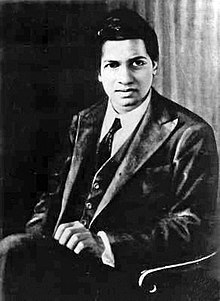Ramanujan
|
Srinivasa Ramanujan FRS |
|
|---|---|
 |
|
| Born |
22 December 1887 Erode, Madras Presidency, British Raj (now Tamil Nadu, India) |
| Died | 26 April 1920 (aged 32) Kumbakonam, Madras Presidency, British Raj (now Tamil Nadu, India) |
| Residence |
Kumbakonam, Madras Presidency Madras, Madras Presidency London, United Kingdom |
| Nationality | Indian |
| Fields | Mathematics |
| Institutions | Trinity College, Cambridge |
| Alma mater | Government Arts College (no degree) Pachaiyappa's College (no degree) Trinity College, Cambridge (BSc, 1916) |
| Thesis | Highly Composite Numbers (1916) |
| Academic advisors |
G. H. Hardy J. E. Littlewood |
| Known for | Landau–Ramanujan constant Mock theta functions Ramanujan conjecture Ramanujan prime Ramanujan–Soldner constant Ramanujan theta function Ramanujan's sum Rogers–Ramanujan identities Ramanujan's master theorem |
| Influences | G. S. Carr |
| Influenced | G. H. Hardy |
| Notable awards | Fellow of the Royal Society |
| Signature | |
Srinivasa Iyengar Ramanujan FRS (pronunciation: ![]() i/ˈʃriːniˌvɑːsə ˈrɑːmɑːˌnʊdʒən/; 22 December 1887 – 26 April 1920) was an Indian mathematician and autodidact who lived during the British Raj. Though he had almost no formal training in pure mathematics, he made substantial contributions to mathematical analysis, number theory, infinite series, and continued fractions. Ramanujan initially developed his own mathematical research in isolation; it was quickly recognized by Indian mathematicians. When his skills became obvious and known to the wider mathematical community, centred in Europe at the time, he began a partnership with the English mathematician G. H. Hardy. The Cambridge professor realized that Srinivasa Ramanujan had produced new theorems in addition to rediscovering previously known ones.
i/ˈʃriːniˌvɑːsə ˈrɑːmɑːˌnʊdʒən/; 22 December 1887 – 26 April 1920) was an Indian mathematician and autodidact who lived during the British Raj. Though he had almost no formal training in pure mathematics, he made substantial contributions to mathematical analysis, number theory, infinite series, and continued fractions. Ramanujan initially developed his own mathematical research in isolation; it was quickly recognized by Indian mathematicians. When his skills became obvious and known to the wider mathematical community, centred in Europe at the time, he began a partnership with the English mathematician G. H. Hardy. The Cambridge professor realized that Srinivasa Ramanujan had produced new theorems in addition to rediscovering previously known ones.
...
Wikipedia
